GRAY SQUIRREL AND DUN FLYMPH
I really like simple flies. If a fly is easy to tie and catches fish, then it’s probably going in my fly box.
Last September I was asked to teach Kat Hise (Ron Hise’s wife and Jack’s Sister-in-Law) how to tie a fly. As I sat in the Rumpus room of the Three Rivers Resort I tried to think up a simple fly that would be easy for her to learn, plus have a few different steps so she could try some varying tying techniques. The fly I came up with is a Gray Squirrel and Dun Flymph.
The day after tying her first fly Kat fished the fly and landed her biggest fish ever on it. The fly was promptly retired to an honored place. I also fished the fly I tied as a sample the following day and caught several very nice cutthroat trout on it.
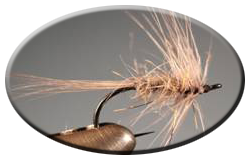
Materials:
- Hook: Grip 14723 or TMC206BL
- Body: Gray Dubbing - Davy Wotton's Squirrel Dubbing with SLF
- Hackle: Hen Hackle that closely matches the dubbing
- Thread: Danville's 70 denier black thread or Gordon Griffiths 12/0 thread to match the body color
To tie this fly you’ll need an upturned eye dry fly hook. I favor Grip 14723 or a TMC 206BL (both are almost identical hooks), but a Mustad will work just as well. The body is dubbed with gray dubbing; I used Davy Wotton’s Squirrel Dubbing with SLF. I really like the sparkle and the spikiness of this dubbing, but any similar dubbing will work just fine. You’ll also need a hen hackle that closely resembles the color of your dubbing and has hackle barbs equal/or greater than the hook gap. Hackle barbs that reach from the hook eye to the hook point are just fine. For thread I use Danville’s 70 denier black thread or Gordon Griffiths 12/0 thread to match the body color.
If you’re using Mustad hooks mash the barb before placing it in your vise. Prep your hackle by stripping the fluff from the base of the hackle. Once the fluff is removed strip 6-8 barbs from each side of the feather. Set these aside as a tail.
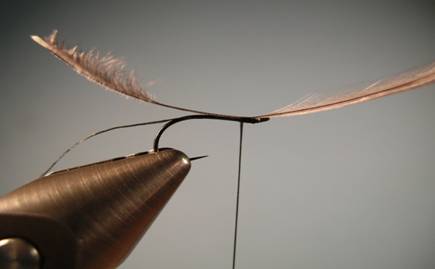
Start your thread right behind the eye and take three to four touching turns toward the bend of the hook. Secure your hackle and tie it in with the shiny (good side) down and the feather pointing out over the eye of the hook. Wrap back to the halfway point on the hook shank, binding the hackle stem to the shank. Break off or cut the excess hackle stem and continue to wrap the thread to the end of the shank.
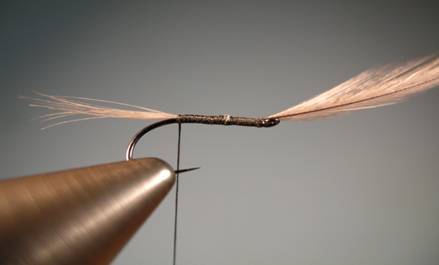
Select the hackle barbs you stripped off of the hackle feather. Tie these in as a tail, about as long as the hook shank. Wrap thread over the hackle barbs, and then back to the tail tie in point.
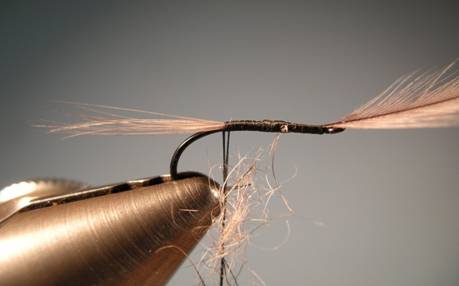
Apply some dubbing wax of your choice to the tying thread. Apply the gray dubbing to the tying thread by pressing sparse amounts into the dubbing wax. Then, spin your bobbin holder in a counter clockwise direction until the thread and dubbing look like spiky chenille. (Alternative methods to this would be to use a dubbing loop or split thread loop.)
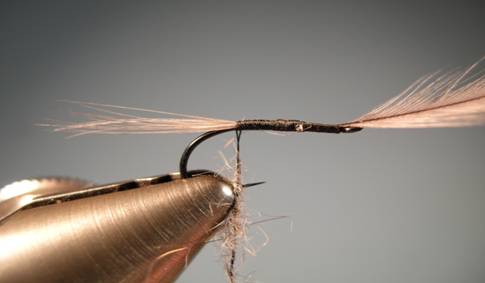
Wrap the dubbed thread forward in touching turns until you reach the hackle tie in point. The reverse direction and wrap back 1/3 to ½ the shank length toward the bend of the hook. Remove any excess dubbing from the thread. Allow the bobbin holder to hang at this point.
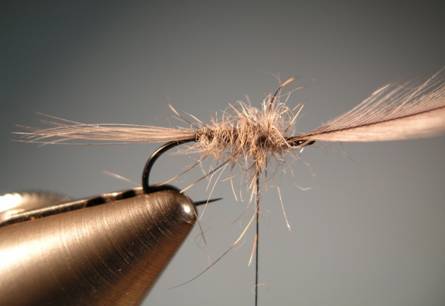
Fold the hackle stem 90 degrees or more to orient the stem for wrapping. Using your fingers or hackle pliers grip the tip of the hackle, and winding toward the hook bend, take 2 touching turns behind the hackle tie in point, and then 3 to 4 open turns back to where the thread is hanging.
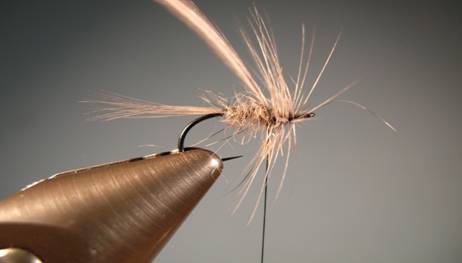
Secure the hackle with one turn of thread, and then wrap the thread in open turns to the eye of the hook. Wiggling the thread as you wrap through the hackle barbs will help in not tying down many hackle barbs. Besides getting your thread back to the hook eye, it also reinforces the hackle stem.
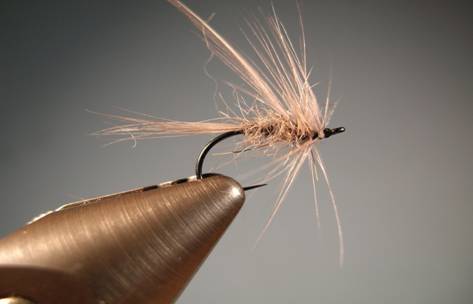
When you reach the eye of the hook, use your fingers to stroke the hackle back slightly and take 2 or 3 thread wraps at the hook eye. Make a neat thread head and whip finish. Trim the thread and apply head cement if you use it.
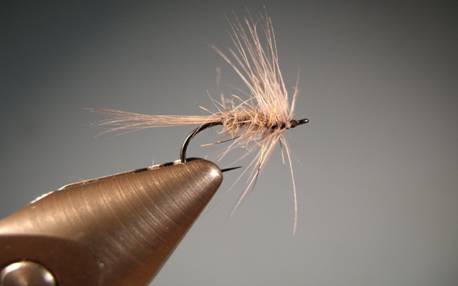
Break off or cut the excess hackle at the tie off point.
Tie several more, and then go fishing. These flies work great when cast upstream like a dry fly where they sit in or just under the surface film. Allow the fly to dead drift past you, and then fish it on the swing as you would a wet fly. I have my best results fishing seams between faster water and slower water, drifting the fly in the faster water, and then swinging into the slower.
I have many colors of hen hackle and dubbing so I also started tying this fly in black, brown, and olive.
REE
For more great info, check out:
Fly Tying Terms
Beginning Fly Tying | Intermediate Fly Tying | Advanced Fly Tying.
